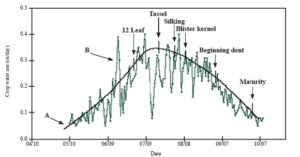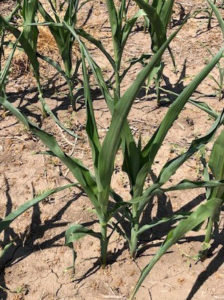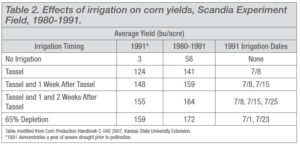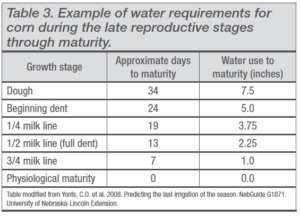- Crop water use is influenced by atmospheric conditions, crop growth stage, planting date and planting density.
- Substantial reductions in yield potential can occur if corn does not receive enough water to meet evapotranspiration demands during peak water use in the reproductive growth stages.
- Irrigation management usually schedules an application of water before the crop reaches a state of severe water stress.
- Understanding how corn water use changes throughout the season can help guide more efficient irrigation applications.
Evapotranspiration
Crop water use, consumptive use and evapotranspiration (ET) are all terms used interchangeably to describe the water consumed by a crop.(1) Evapotranspiration (ET) is used to describe the movement of water through evaporation (E) from the soil and plant surfaces and transpiration (T) through the plant. Transpiration is the movement of water from the soil into plant roots, through plant stems and leaves, and back out into the atmosphere. Transpiration is an important concept because yield is related to the amount of water a plant transpires. Understanding corn water use and the factors that affect it can help guide more efficient irrigation applications.
Factors that Influence Evapotranspiration
Factors that affect ET and irrigation scheduling decisions include:
Crop growth stage. Corn water requirements change throughout the season. Young plants transpire less than larger plants due to a smaller leaf surface area. Corn requires the most water just prior to and during the early reproductive growth stages. Relative maturity. A full-season corn product will use more water over the course of the season compared to a shorter-season product grown in the same location. While longer-season corn products use more water, they may also have a higher yield potential if heat units and adequate water are available.
Weather conditions. The ability of the atmosphere to evaporate water is the driving force for soil water evaporation and transpiration. Daily ET is influenced by solar radiation, air temperature, relative humidity, and wind. High air temperatures, low humidity, clear skies, and high winds cause a large evaporative demand that can exceed 0.50 inches of water per day in some areas when the corn crop is in the early reproductive stages.(1)
Soil water holding capacity and soil water content. Soil type dictates the maximum amount of water a soil can hold and how much of that water will be available to plants. Fine textured soils can hold more water than coarse textured soils. As the soil dries, it becomes more difficult for plants to extract water. When the soil water profile is full (field capacity), plants use water at the maximum rate. As the water content of the soil drops, plants are less able to extract the water. Soil water begins to limit transpiration when the soil dries below a threshold generally halfway between field capacity and wilting point.

Figure 1. Example of long-term daily average (A) and individual year (B) corn water use with select growth stages.
Source: Kranz, W.L. et al. 2008. Irrigation management for corn. NebGuide G1850. University of Nebraska-Lincoln Extension.
Corn Water Use and Irrigation Requirements by Growth Stage
High yielding corn requires approximately 22 to 30 inches of water per year depending on planting date, planting density, maturity group, location, and weather conditions.(2) Corn requires the most water during the early reproductive growth stages (Table 1), which are also the most sensitive stages to water stress. Substantial reductions in yield can occur if corn does not receive enough water to meet ET demands during this critical water use period.
Early Growth Stages
Corn uses very little water during the seedling stage. If early season precipitation and stored soil moisture are adequate for seedling emergence and early plant development, irrigation is not recommended immediately following planting. Without the plant canopy to shade the soil surface, much of the irrigation could be lost to evaporation. However, there are two scenarios where overhead sprinkler irrigation is recommended just after a corn crop is seeded.
• If after planting the surface soil moisture has dried to the point where there is not enough moisture to meet the germinating seed requirement for uniform germination and emergence, then an irrigation application or two (0.5 to 1.0 inches/application), depending on soil type, is recommended. This is to ensure uniform emergence and reduce the occurrence of late emerging seedlings or skips in the stand due to seeds in dry soil, delayed germination, or failure to germinate at all.
• If pre-emergence herbicides are applied just before or after planting, a light irrigation (.5 to 1.0 inches) is often used to incorporate these herbicides into the top two inches of the soil profile to position the herbicide in the soil zone of germinating weed seeds.

Figure 2. Corn plants at six leaf vegetative growth stage under heat and moisture stress.
Producers should rely on stored soil moisture and natural precipitation as much as possible during the early growth stages as an early irrigation can also cool the soil and delay seed germination and early growth.
Vegetative Stages
The vegetative stages of corn are often considered the least sensitive stages to water stress yield loss. If irrigation supplies are limited, the vegetative stages may provide an opportunity to conserve irrigation for the reproductive stages where it will have the most impact on yield potential (Figure 2).
Early Reproductive Stages
Corn water use peaks during the early reproductive stages. Water stress should be avoided during tasseling, silking, and pollination. Water stress during silking can have the greatest impact on yield potential due to desiccation of the silks and pollen grains, which can result in poor pollination.(1) Corn water demands often exceed precipitation amounts during these critical growth stages (Table 2). It is important to plan ahead by knowing the capacity of the irrigation system to ensure that adequate water is available to the crop through these growth stages.

Dough through Dent Stages
Corn water use rates steadily decrease from the dough stage through maturity due to a lower evaporative demand (shorter days, lower temperatures, lower solar radiation), a loss of transpiring leaf area as lower leaves begin to die, and changes in plant physiology.1 Corn continues to require roughly 30% of its seasonal water requirement at the beginning of the dough stage (Table 3). For optimal grain development and maximum yield potential, corn requires water right up to physiological maturity. Water stress during the dough through dent stages can accelerate maturity, prohibiting kernels from reaching their full potential size and weight (poor kernel test weight).(3)

Maturity
Water is no longer needed for kernel growth after physiological maturity (black layer) and no yield benefits can be achieved with additional irrigation. Allowing soils to dry at maturity is a good strategy for avoiding compaction that can be caused by harvesting machinery on wet soils.
Water Use Efficiency
Water use efficiency (WUE) is defined as the amount of grain produced per unit of water used by a crop. The concept of WUE has been around for a long time but research is ongoing to help determine what can be done to grow more crop with less water. Enhancing WUE at the canopy level can be achieved by adopting practices that reduce the soil water evaporation component and divert more water into transpiration which can be achieved through crop residue management, mulching, row spacing, genetic response, and irrigation system efficiency.(4)
Residue Management and Tillage System Response
The soil water evaporation component of ET can be reduced with conservation tillage and strip tillage which can be increased with surface crop residue. Adding crop residue to the soil surface has shown benefits in decreasing soil water evaporation and increasing WUE in semi-arid regions.4 Tillage increases the exposed surface area of the soil which increases evaporation and runoff, destroys crop residue that can catch rain and snow, and may reduce water infiltration rate because of compaction that can be created during the tillage process. Surface residue also helps increase infiltration rates by limiting the amount of surface sealing (crusting) created by rainfall and irrigation droplets. When a droplet hits a bare soil surface there is a physical disintegration of soil aggregates and their compaction, caused by the impact of raindrops, which can cause soil surface sealing and result in poor water intake rates. The residue is a physical barrier that does not allow the droplet to impact the soil surface. Surface residue also helps reduce runoff by creating obstructions that limit water movement and allow more time for water to percolate into the soil profile.
Row Spacing Response
Narrow rows can help reduce the time the soil is not covered and may increase WUE by decreasing soil evaporation. This may be a potential water management tool to increase WUE especially for water limited environments or under rainfed environments with variable rainfall during the growing season. Evaporation can be suppressed in irrigated fields by increasing planting density to encourage rapid ground cover. In general, more of a yield response to narrow rows is expected to occur in northern production states, likely due to their shorter growing seasons. There is an advantage to narrow rows for yield increase in a high-yield environment and no advantage in the mid- to low-yield environments.(5)
Genetic Response
The concept of WUE has been proposed in plant breeding to help identify water use efficient genotypes under changing climate regimes, heat and water-deficit stress, and interactions among them. It has been demonstrated that apparent photosynthesis and transpiration under water-deficit conditions were related to WUE and could be used as tools to assess comparisons in genetic material. The resilience of genetic material to stress, e.g., temperature or water, will provide the newer genetic material with greater WUE.(4)
Irrigation Response
The type of irrigation and irrigation system design can drastically affect the WUE of a corn crop. No irrigation system is 100% efficient but converting a flood or furrow irrigation system to overhead sprinkler irrigation or even realizing more efficiency by converting to a subsurface drip system, can drastically increase irrigation efficiency.
Furrow or flood (surface) type irrigation may only be 50% efficient when you consider the potential for run-off and application rate variability. Excessively long irrigation runs result in water being lost to the crop by deep percolation on the upstream end of the field by the time the downstream end is adequately irrigated. And by the time the downstream end is adequately irrigated there is the potential for excessive runoff. WUE is negatively affected by both potential water losses to the crop.
Overhead sprinkler irrigation WUE can be drastically affected by the height of the irrigation nozzle above the canopy and the water droplet size created by the nozzle package. The wind velocity along with small irrigation droplet size can reduce the irrigation efficiency by increased evaporation before the water droplet hits the soil surface. Another area of poor WUE is the area watered by the end gun on many systems. Many systems have had the end gun removed because the WUE for the area irrigated by the end gun is often the least efficient area irrigated under the overhead irrigation system. Remote system monitoring can now be used to check on a system’s function and even start or stop a system which can have a positively effect on the WUE.
Subsurface drip-irrigation (SDI) is a way of irrigating crops through plastic tubes placed under the soil surface. These systems reduce the soil water evaporation, from between the plant rows, early in the season and limits almost all the evaporation component from the canopy. Using an SDI system can help provide high WUE and potential savings of 25-50% compared to flood irrigation. Using SDI also has a positive effect on the environment through reduced nitrate leakage in the lower soil layers, unlike other irrigation systems especially flood or furrow irrigation systems. One of the reasons that SDI is not used on more acres is the initial cost of installation. The investment to install this type of the system can range from $2,000 to $4,000 per acre.(6) When considering an irrigation system for corn production any system or nozzle package that can shift more of the water use from evaporation to transpiration can positively affect the WUE.2
Cover Crop Response
Cover crops have the potential to reduce soil erosion and compaction, increase water holding capacity, soil organic matter, and suppress weeds which can all have a positive effect on the WUE of a corn crop. Different cover crop species and different cover crop planting dates may have specific effects on cropping systems especially in semi-arid areas where the moisture available to grow a crop has a substantial effect on corn yield potential. Timing of cover crop termination is key to avoiding excessive cover crop growth, water use, and nitrogen immobilization, and consequently potentially reducing corn grain yield.(7) WUE has increased over time because the grain yields have increased while water use has remained relatively constant.
Article Link – Corn Irrigation Timing and Water Use Efficiency
